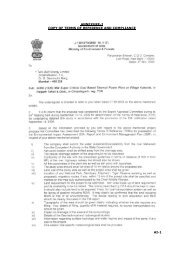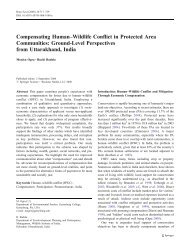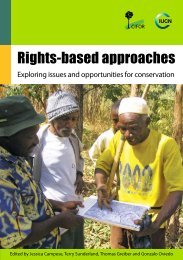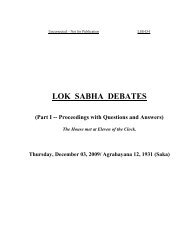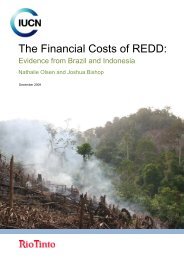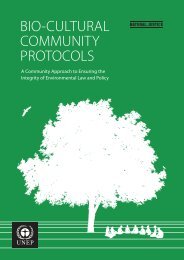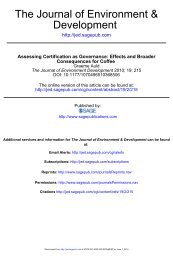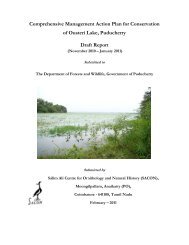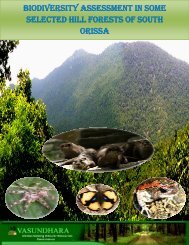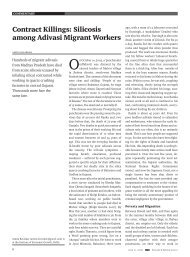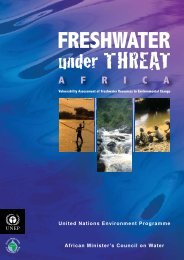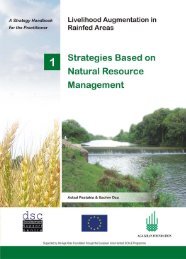Integrated River Basin Planning – Replicable ... - India Water Portal
Integrated River Basin Planning – Replicable ... - India Water Portal
Integrated River Basin Planning – Replicable ... - India Water Portal
Create successful ePaper yourself
Turn your PDF publications into a flip-book with our unique Google optimized e-Paper software.
<strong>Integrated</strong> <strong>River</strong> <strong>Basin</strong> <strong>Planning</strong>: <strong>India</strong> and the EU share experience on policy and practice<br />
IWRM Progress in Kerala’s Pamba <strong>Basin</strong><br />
The Authority has no capacity to implement such a communication strategy.<br />
Other organizations outside the government may be better placed to provide the<br />
services. The PRBA remains the overall facilitator. A focused strategy is needed<br />
here, which needs to include, over time, the minimum required level of stakeholder<br />
involvement and guidelines to achieve it.<br />
Meaningful participation of stakeholders in the management of the basin requires<br />
effective communication and information exchange between all relevant role<br />
players at state and at basin level. A website with information on activities in the<br />
basin can serve as a water information portal as well as a platform for information<br />
exchange between stakeholders.<br />
Effective stakeholder participation also requires that all stakeholders have the<br />
necessary capacity to meaningfully interact and contribute to decision-making on<br />
matters relating to the management of the basin. This requires the strengthening<br />
of the PRBA’s future members’ capacity to interact with stakeholders and include<br />
them in decision-making. Capacity can be developed through the suggested<br />
regular basin forums.<br />
9.2 Strengths and constraints in the<br />
management framework<br />
As noted earlier, the universally accepted three pillars of IWRM are (i) Enabling<br />
Environment; (ii) Institutional Framework; and (iii) Management Instruments. An<br />
enabling environment stimulates desirable work practices of IWRM and forms an<br />
essential pre-condition.<br />
Examples of an enabling environment include nurturing of integrated policy<br />
perspective, holistic legal provisions and a culture of collaborative working across<br />
sectors. This enabling environment pre-condition will have to be supported by the<br />
other two pillars, i.e. establishment of an appropriate institutional framework and<br />
the development and operationalization of required management instruments.<br />
The current management constraints in institutionalizing IWRM in the Pamba <strong>River</strong><br />
<strong>Basin</strong> are described below along with appropriate responses. These constraints<br />
and suggested responses were essentially a compilation of articulation by the<br />
participants of the stakeholder consultation workshops held in the past 10 months<br />
over 2010.<br />
The essence of each of the constraints indicated and their implications across<br />
three IWRM pillars in the new RBO regime are explained in Table 14.<br />
Table 14<br />
Management<br />
Constraint<br />
Weak staff capacity<br />
both in number and<br />
Expertise in IWRM<br />
Management<br />
Constraint<br />
Weak linkages of<br />
WR department with<br />
important catchment<br />
organizations, resulting<br />
in fragmented<br />
responsibilities at<br />
the field level (e.g.<br />
forestry and revenue<br />
departments)<br />
Lack of scientific<br />
method and systems<br />
to assess demand<br />
for eco-system<br />
management<br />
Weak policy framework<br />
Inadequate<br />
sewage and waste<br />
management systems<br />
and methods<br />
Absence of policy<br />
framework to prevent<br />
reclamation of<br />
productive wetland for<br />
non-farming activities,<br />
resulting in man-made<br />
disasters<br />
Management constraints and suggested responses (Contd...)<br />
Enabling<br />
Environment<br />
Enabling<br />
Environment<br />
The culture<br />
of integrated<br />
working of various<br />
departments at<br />
the cutting edge<br />
level needs to be<br />
promoted<br />
Defining clear<br />
policies<br />
Making multiple<br />
technology<br />
choices available<br />
for on-site and offsite<br />
sanitation<br />
Defining waste<br />
management<br />
policy and tuning<br />
it to meet area<br />
specific needs<br />
Enacting laws,<br />
rules and<br />
regulations<br />
Institutional<br />
Framework<br />
Identify a nodal<br />
department to<br />
coordinate all staff<br />
capacity development<br />
activities<br />
Institutional Framework<br />
PRBA to take a lead<br />
role in catchment area<br />
treatment and ensure<br />
integrated working, thus<br />
avoiding overlaps and<br />
gaps in working<br />
PRBA to play a nodal<br />
agency role and<br />
institutionalize required<br />
scientific systems<br />
in participating<br />
departments<br />
Enacting laws and<br />
enforcing regulations<br />
Institutionalizing<br />
decentralized waste<br />
management solutions<br />
(defining norms and<br />
practices)<br />
Management<br />
Instruments<br />
Identify ways and<br />
means of promoting<br />
community<br />
involvement<br />
Management<br />
Instruments<br />
Develop, promote<br />
and institutionalize<br />
technical<br />
competence in IWRM<br />
working (e.g. silt<br />
management, biofencing,<br />
community<br />
participation in basin<br />
management etc)<br />
Standardize<br />
assessment<br />
methods to<br />
understand demandsupply<br />
situation.<br />
Develop models for<br />
ensuring minimum<br />
flow in the river.<br />
Institutionalize<br />
capacity<br />
development<br />
STP systems,<br />
decentralized<br />
sewage<br />
management<br />
Supportive systems<br />
at local level<br />
Public education<br />
Capacity<br />
development<br />
systems<br />
Responsibility<br />
RBO, LSG<br />
Responsibility<br />
PRBA, LSG,<br />
Department of<br />
Forestry<br />
PRBA and related<br />
departments<br />
PRBA, LSG, KWA,<br />
SPCB<br />
PRBA, LSG,<br />
District<br />
Administration<br />
Capacity<br />
development<br />
systems<br />
52 53



